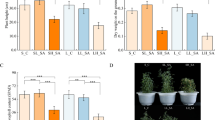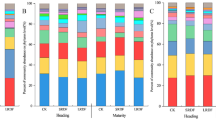Abstract
The Yellow River Delta is the largest and youngest estuarine and coastal wetland in China and is experiencing the most active interactions of seawater and freshwater in the world. Bacteria played multifaceted influence on soil biogeochemical processes, and it was necessary to investigate the intermodulation between the soil factors and bacterial communities. Soil samples were collected at sites with different salinity degree, vegetations, and interference. The sequences of bacilli were tested using 16S rRNA sequencing method and operational taxonomic units were classified with 97% similarity. The soil was highly salinized and oligotrophic, and the wetland was nitrogen-restricted. Redundancy analysis suggested that factors related with seawater erosion were principal to drive the changes of soil bacterial communities and then the nutrient level and human disturbance. A broader implication was that, in the early succession stages of the coastal ecosystem, seawater erosion was the key driver of the variations of marine oligotrophic bacterial communities, while the increasing nutrient availability may enhance in the abundance of the riverine copiotrophs in the late stages. This study provided new insights on the characteristics of soil bacterial communities in estuarine and coastal wetlands.





Similar content being viewed by others
Data availability
All data generated or analyzed in current study was included in this article.
References
Bach EM, Williams RJ, Hargreaves SK, Yang F, Hofmockel KS (2018) Greatest soil microbial diversity found in micro-habitats. Soil Biol Biochem 118:217–226
Baker BJ, Lazar CS, Teske AP, Dick GJ (2015) Genomic resolution of linkages in carbon, nitrogen, and sulfur cycling among widespread estuary sediment bacteria. Microbiome 3:14. https://doi.org/10.1186/s40168-015-0077-6
Bastida F, Torres IF, Moreno JL, Baldrian P, Ondoño S, Ruiz-Navarro A, Hernandez T, Richnow HH, Starke R, García C, Jehmlich N (2016) The active microbial diversity drives ecosystem multifunctionality and is physiologically related to carbon availability in Mediterranean semi-arid soils. Mol Ecol 25:4660–4673
Bradshaw C, Kautsky U, Kumblad L (2012) Ecological stoichiometry and multielement transfer in a coastal ecosystem. Ecosystems 15:591–603
Chen C, Han Y, Chen H, Chen X, Huang Z (2019) Meta-analysis shows positive effects of plant diversity on microbial biomass and respiration. Nat Commun 10:1332
Cheng Q, Lou G, Huang W, Li X (2017) Assessment and potential sources of metals in the surface sediments of the Yellow River Delta, Eastern China. Environ Sci Pollut Res 24(11):1–9
Cheng Q, Zhou W, Zhang J, Shi L, Xie Y, Li X (2019) Spatial variations of arsenic and heavy metal pollutants before and after the water-sediment regulation in the wetland sediments of the Yellow River Estuary, China. Mar Pollut Bull 145:138–147
China soil database (CSDB) (2010). http://vdb3.soil.csdb.cn/. Accessed 20 July 2019
Delgado-Baquerizo M, Oliverio AM, Brewer TE, Benavent-González A, Eldridge DJ, Bardgett RD, Maestre FT, Singh BK, Fierer N (2018) A global atlas of the dominant bacteria found in soil. Science 359:320–325
Ding L, Su J, Sub J-Q, Zhu Y, Cao Z (2017) Bacterial succession along a long-term chronosequence of paddy soil in the Yangtze River Delta, China. Soil Biol Biochem 104:59–67
Dini-Andreote F, Stegen JC, van Elsas JD, Salles JF (2015) Disentangling mechanisms that mediate the balance between stochastic and deterministic processes in microbial succession. Proc Natl Acad Sci U S A 112:E1326–E1332
Eisenhauer N, Lanoue A, Strecker T, Scheu S, Steinauer K, Thakur MP, Mommer L (2017) Root biomass and exudates link plant diversity with soil bacterial and fungal biomass. Sci Rep 7:1–8
Fanin N, Kardol P, Farrell M, Kempel A, Ciobanu M, Nilsson MC, Gundale MJ, Wardle DA (2019) Effects of plant functional group removal on structure and function of soil communities across contrasting ecosystems. Ecol Lett 22:1095–1103. https://doi.org/10.1111/ele.13266
Freedman Z, Zak DR (2015) Soil bacterial communities are shaped by temporal and environmental filtering: evidence from a long-term chronosequence. Environ Microbiol 17:3208–3218
Guo H, Nasir M, Lv J, DaiY GJ (2017) Understanding the variation of microbial community in heavy metals contaminated soil using high throughput sequencing. Ecotoxicol Environ Saf 144:300–306
Hadjispyrou SA, Anagnostopoulos A, Nicholson K, Nimfopoulos MK, Michailidis KM (1998) Correlation of the methylating capacity of river and marine sediments to their organic sediment index. Environ Geochem Health 20(1):19–27
Higashioka Y, Kojima H, Watanabe M, Fukui M (2013) Desulfatitalea tepidiphila gen. nov., sp. nov., a sulfate-reducing bacterium isolated from tidal flat sediment. Int J Syst Evol Microbiol 63:761–765
Hu Y, Wang L, Fu X, Yan J, Wu J, Tsang Y, Le Y, Sun Y (2016) Salinity and nutrient contents of tidal water affects soil respiration and carbon sequestration of high and low tidal flats of Jiuduansha wetlands in different ways. Sci Total Environ 565:637–648
Jeanbille M, Buee M, Bach C, Cebron A, Frey-Klett P, Turpault MP, Uroz S (2016) Soil parameters drive the structure, diversity and metabolic potentials of the bacterial communities across temperate beech forest soil sequences. Microb Ecol 71:482–493
Koh HW, Rani S, Kim SJ, Moon E, Nam SW, Rhee SK, Park SJ (2017) Halomonas aestuarii sp. nov., a moderately halophilic bacterium isolated from a tidal flat. Int J Syst Evol Microbiol 67:4298–4303
Kuang J, Huang L, Chen L, Hua Z, Li S, Hu M, Li J, Shu W (2012) Contemporary environmental variation determines microbial diversity patterns in acid mine drainage. ISME J 7(5):1038–1050
Li A, Han X, Lin L, Zhang M, Zhu H (2018) Gramella antarctica sp. nov., isolated from marine surface sediment. Int J Syst Evol Microbiol 68:358–363
Li W, Lv X, Ruan J, Yu M, Song Y, Yu J, Dong M (2019) Variations in soil bacterial composition and diversity in newly formed coastal wetlands. Front Microbiol 9:3256
Lu D, Xia J, Dunlap CA, Rooney AP, Du Z (2017) Gracilimonas halophila sp. nov., isolated from a marine solar saltern. Int J Syst Evol Microbiol 67:3251–3255
Lv X, Ma B, Yu J, Chang S, Xu J, Li Y et al (2016) Bacterial community structure and function shift along a successional series of tidal flats in the Yellow River Delta. Sci Rep 6:36550. https://doi.org/10.1038/srep36550
Morrissey EM, Gillespie JL, Morina JC, Franklin RB (2014) Salinity affects microbial activity and soil organic matter content in tidal wetlands. Glob Chang Biol 20:1351–1362
Munoz R, Rossello-Mora R, Amann R (2016) Revised phylogeny of Bacteroidetes and proposal of sixteen new taxa and two new combinations including Rhodothermaeota phyl. nov. Syst Appl Microbiol 39:281–296
Pribyl DW (2010) A critical review of the conventional SOC to SOM conversion factor. Geoderma 156:75–83
Rabbi SM, Daniel H, Lockwood PV, Macdonald C, Pereg L, Tighe M, Wilson BR, Young IM (2016) Physical soil architectural traits are functionally linked to carbon decomposition and bacterial diversity. Sci Rep 6:33012
Rinklebe J, Langer U (2006) Microbial diversity in three floodplain soils at the Elbe River (Germany). Soil Biol Biochem 38:2144–2151
Rostan JC, Amoros C, Juget J (1987) The organic content of the surficial sediment: a method for the study of ecosystems development in abandoned river channels. Hydrobiologia 148:45–62
Shao P, Liang C, Rubert-Nason K, Li X, Xie H, Bao X (2019) Secondary successional forests undergo tightly-coupled changes in soil microbial community structure and soil organic matter. Soil Biol Biochem 128:56–65
Tang L, Zhang Z, Xie R, Jiao N, Zhang Y (2018) Salinisphaera aquimarina sp. nov., isolated from seawater. Int J Syst Evol Microbiol 68:1130–1134
Trivedi P, Delgado-Baquerizo M, Trivedi C, Hu H, Anderson IC, Jeffries TC, Zhou J, Singh BK (2016) Microbial regulation of the soil carbon cycle: evidence from gene-enzyme relationships. ISME J 10:2593–2604
Wang C (2018) Spatial and temporal variation of microbial community structure in the Bohai Sea and its response to environmental pressure. Dissertation, Yantai Institute of Coastal Zone Research, Chinese Academy of Sciences
Wang W, Sardans J, Wang C, Zeng C, Tong C, Asensio D, Penuelas J (2015) Ecological stoichiometry of C, N, and P of invasive Phragmites australis and native Cyperus malaccensis species in the Minjiang River tidal estuarine wetlands of China. Plant Ecol 216:809–822
Wang Y, Liu Y, Zhang Z, Zheng Y, Zhang X (2016) Marinicella pacifica sp. nov., isolated from seawater. Int J Syst Evol Microbiol 66:2313–2318
Wu Y, Yan J, Fang C, Huo Y, Ma W, Zhang D, Wang C, Xu X (2018) Gracilimonas amylolytica sp. nov., isolated from deep-sea sediment. Int J Syst Evol Microbiol 68:1713–1718
Xv C, Gu S, Liu Z, Zhang N, Yu L (2016) Characteristics of the river mouth bar in the past 14 years of the Yellow River Water-Sediment Regulation. Yellow River 38(10):69–73 (in chinese)
Yan J, Wang L, Hu Y, Tsang Y, Sun Y (2018) Plant litter composition selects different soil microbial structures and in turn drives different litter decomposition pattern and soil carbon sequestration capability. Geoderma 319:194–203
Yang S, Li C (1999) Characteristic element compositions of the Yangtze and the Yellow River sediments and their geological background. Mar Geol Quat Geol 19(2):19–26 (in Chinese)
Yarwood SA, Högberg MN (2017) Soil bacteria and archaea change rapidly in the first century of Fennoscandian boreal forest development. Soil Biol Biochem 114:160–167
Yu J, Li Y, Han G, Zhou D, Fu Y, Guan B, Wang G, Ning K, Wu H, Wang J (2014) The spatial distribution characteristics of soil salinity in coastal zone of the Yellow River Delta. Environ Earth Sci 72:589–599
Yuan J, Ding W, Liu D, Kang H, Freeman C, Xiang J, Lin Y (2015) Exotic Spartina alterniflora invasion alters ecosystem–atmosphere exchange of CH4 and N2O and carbon sequestration in a coastal salt marsh in China. Glob Chang Biol 21:1567–1580
Zeglin LH, Wang B, Waythomas C, Rainey F, Talbot SL (2016) Organic matter quantity and source affects microbial community structure and function following volcanic eruption on Kasatochi Island, Alaska. Environ Microbiol 18:146–158
Zhang C, Liu G, Xue S, Wang G (2016) Soil bacterial community dynamics reflect changes in plant community and soil properties during the secondary succession of abandoned farmland in the Loess Plateau. Soil Biol Biochem 97:40–49
Zhang J, Zhang X, Liu Y, Xie S, Liu Y (2014) Bacterioplankton communities in a high-altitude freshwater wetland. Ann Microbiol 64:1405–1411. https://doi.org/10.1007/s13213-013-0785-8
Zhou Z, Wang C, Jiang L, Luo Y (2017) Trends in soil microbial communities during secondary succession. Soil Biol Biochem 115:92–99
Acknowledgments
We appreciated Michael E Willmore and Jianhua Li for their help to improve the manuscript and referees for their suggestions.
Funding
This work was supported by the Natural Science Foundation of Henan Province (grant number 182300410165) and Ph.D. Science Foundation of North China University of Water Resources and Electric Power (grant number 201901002).
Author information
Authors and Affiliations
Contributions
All authors contributed to the study conception and design and also took part in the field survey and the soil sampling. Physical and chemical parameters of the samplings were measured and analyzed by Yang Xue and Wang Ding. The materials on bacterial communities were performed by Cheng Qingli and Chang Huiping. The first draft of the manuscript was written by Cheng Qingli and all authors commented on previous versions of the manuscript. This revision was mainly contributed by Cheng Qingli and Wang Wenlin. All authors read and approved the final manuscript.
Corresponding author
Ethics declarations
Conflict of interest
The authors declare that they have no conflict of interest.
Ethical approval
Not applicable.
Consent to participate
Not applicable.
Consent to publish
Not applicable.
Additional information
Responsible Editor: Alexandros Stefanakis
Publisher’s note
Springer Nature remains neutral with regard to jurisdictional claims in published maps and institutional affiliations.
Supplementary information
ESM 1
(DOC 464 kb)
Rights and permissions
About this article
Cite this article
Cheng, Q., Chang, H., Yang, X. et al. Salinity and nutrient modulate soil bacterial communities in the coastal wetland of the Yellow River Delta, China. Environ Sci Pollut Res 28, 14621–14631 (2021). https://doi.org/10.1007/s11356-020-11626-x
Received:
Accepted:
Published:
Issue Date:
DOI: https://doi.org/10.1007/s11356-020-11626-x




